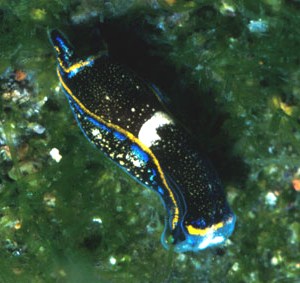
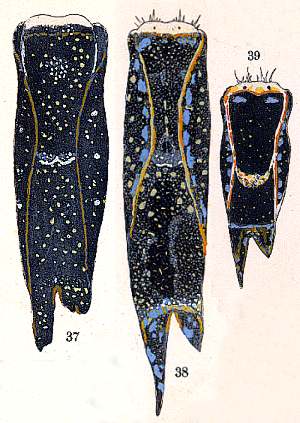
Chelidonura africana
Pruvot-Fol, 1953
Order: CEPHALASPIDEA
Superfamily: PHILINOIDEA
Family: Aglajidae
DISTRIBUTION
Azores, Morocco, western Mediterranean, [Italy, Spain]. It is also suggested on the Forum that this species has a Caribbean population as well.
PHOTO
Upper: São Miguel, Azores. July 1988. Photo: T.M. Gosliner
Lower: 3 specimens from Morocco. Plate 3, figs 37-39 - from Pruvot-Fol 1953.
The animal is black with scattered white flecks. There is usually a white band across the front of the head shield and another on its posterior edge, but in some cases one or both of these white bands can be reduced or absent. There is also an orange or yellow line across the head, behind the white band, and another orange-yellow line edging the parapodia and caudal processes. There are bright blue spots associated with the ornage line. On the head, there can be two blue patches just behind the transverse orange line, and on the parapodia there can be a row of blue spots forming a submarginal line below the orange border. On the caudal lobes ['tails'] large bkue spots can be present.
Some earlier authors have considered that Pruvot-Fol's 3 illustrations may represent 2 or 3 distinct species but that seems unlikely. The variation in colour pattern does not seem excessive when compared with other species in the family. Garacia & Garcia (1984) describe the species form the Strait of Gibraltar and consider C. italica Sordi 1980, from the Tyrrhenian Sea, Italy to be a synonym.
Note added 6 January 2004: As I discuss in a separate message, the Caribbean C. berolina is almost certainly a synonym of C. africana.
Note added 31 August 2007: As I discuss in a separate message, the Caribbean C. cubana is another possible synonym of C. africana.
References:
• Yonow, N. (1994). A new species and a new record of Chelidonura from the Red Sea (Cephalaspidea: Aglajidae), Journal Conch. London, 35: 141-147
• Garcia, J.C. & Garcia, F.J. (1984). Sobre la presencia de Chelidonura africana Pruvot-Fol Mollusca: Opisthobranchia) en el litoral Iberico. Boll. Malacol., Milano, 20 (1-4): 77-82
• Gosliner, T.M. (1980). Systematics and phylogeny of the Aglajidae (Mollusca: Opisthobranchia). Zool. J. Linn. Soc. London, 68: 325-360
• Marcus, E. (1976). Marine euthyneuran gastropods from Brazil (3). Studies on Neotropical Fauna and Environment, 11: 5-23
• Martinez, E., Ballesteros, M., Avila, C., Dantart, L. & Cimino, G. (1993) The family Aglajidae (Opisthobranchia: Cephalaspidea) in the Iberian Peninsula. Iberus, 11(1): 15-29.
• Martinez, E., Malaquias, M.A.E. & Cervera, J.L. (2002). Chelidonura africana Pruvot-Fol, 1953 (MOLLUSCA, GASTROPODA): proposed designation of a neotype. Journal of Conchology, 37(4): 349-354.
• Pruvot-Fol, A. (1953) Etude de quelques opisthobranches de la cote Atlantique du Maroc et du Senegal. Travaux de l'Institute Scientifique Cherifien, Zoologie, 5: 1-105. (Pls.1-3)
• Rudman, W.B. (1974). A comparison of Chelidonura, Navanax, and Aglaja with other genera of the Agaljidae. (Opisthobranchia: Gastropoda). Zool. J. Linn. Soc. London, 54: 185-212
• Sordi, M. (1980). Una nuova specie di Aglajidae (Gasrtopoda: Opisthobranchia) vivente nel mar Tirreno: Chelidonura italica Sordi. Atti Soc. tosc. Sci. nat. Mem Seria B, 87: 285-297
Rudman, W.B., 2003 (May 15) Chelidonura africana Pruvot-Fol, 1953. [In] Sea Slug Forum. Australian Museum, Sydney. Available from http://www.seaslugforum.net/find/chelafri
Related messages
Chelidonura africana from Croatia
August 24, 2006
From: Tom Turk
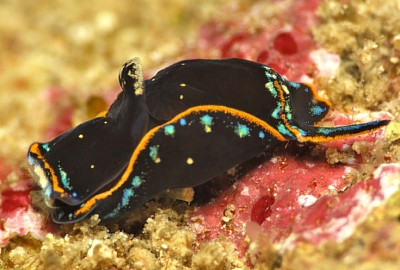
Dear Bill,
I am sending you a photo that might be a species of Chelidonura from the Adriatic Sea. The size of the animal is about 1 cm. I am aware of only one similar picture from E. Trainito book Mediterranean Harlequins where it is listed as an unidentified species.
Locality: Sušac island , 15 m, Croatia, Adriatic sea, July 2006, coralline bottom. Length: approx 1 cm. Photographer: Borut Furlan.
Tom Turk
tom.turk@bf.uni-lj.si
Turk, T., 2006 (Aug 24) Chelidonura africana from Croatia. [Message in] Sea Slug Forum. Australian Museum, Sydney. Available from http://www.seaslugforum.net/find/17561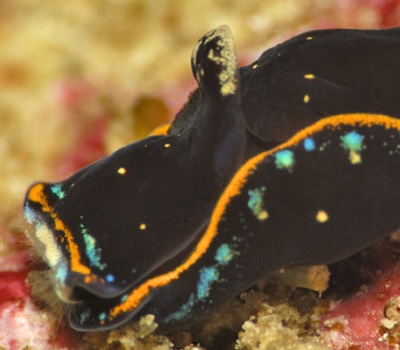
Dear Tom,
This is Chelidonura africana. If you have a look at the species Fact Sheet you will see Fig 39, in Pruvot-Fol's original desciption from Morocco, looks very similar to your animal. It's nice to get a photo from the Mediterranean illustrating a 'typical' specimen
Best wishes,
Bill Rudman
Chelidonura africana? from Cozumel, Mexico
August 31, 2005
From: James Lyle
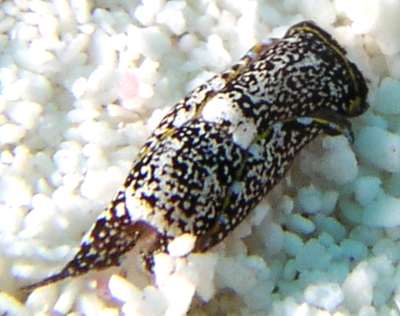
I took this photograph of what I believe to be Chelidonura africana in Cozumel, Mexico. Do you confirm the identification? It was only about 2mm long.
Locality: Colombia Reef, Cozumel, Quintana Roo, Mexico. Caribbean. Depth: 15 meters. Length: 2 mm.12 August 2005. sand flat. Photographer: Jim Lyle
Jim Lyle
jlyle@scubadiving.com
Lyle, J.L., 2005 (Aug 31) Chelidonura africana? from Cozumel, Mexico. [Message in] Sea Slug Forum. Australian Museum, Sydney. Available from http://www.seaslugforum.net/find/14673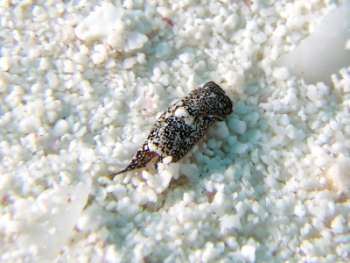
Dear Jim,
Yes I think this is C. africana. It is the other end of the colour pattern range from Anne DuPont's recent animals [message #14644 ] from the Bahamas. In your animal you can only see traces of the orange banding which are so clear in her animals. In shape and size and colour variation it reminds me of the Indo-West pacific species C. sandrana.
Best wishes,
Bill Rudman
Aglaja hummelincki or Chelidonura africana?
August 29, 2005
From: Anne DuPont
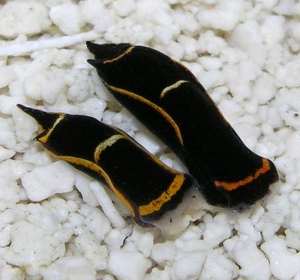
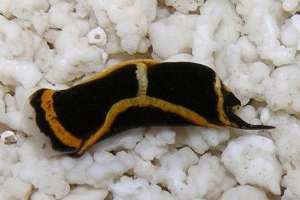
Hello Bill,
I found these in the southern Bahamas in the sand during the day. Are they Aglaja hummelincki or Chelidonura africana? There are no blue dots on the parapodia that I usually see when photographing them.
Location: Monument Beach, Stocking Island, Exumas, Bahamas. Size: Larger specimen appx 8 mm, smaller specimen appx 5 mm. March 9, 2005. Depth: 5-6 feet
Thank you,
Anne DuPont
Delray Beach, FL
akdupont@bellsouth.net
DuPont, A., 2005 (Aug 29) Aglaja hummelincki or Chelidonura africana?. [Message in] Sea Slug Forum. Australian Museum, Sydney. Available from http://www.seaslugforum.net/find/14644Dear Anne,
These are an extreme colour form of an animal I identified for you in an earlier message as C. berolina [see #9573], a species which I later decided was a Caribbean population of C. africana [see #11810; #12457]. One of the animals in your earlier message had the same yellow bands, but also had white mottling all over the body as well. As I discussed earlier, Aglaja hummelincki was described from preserved animals which were said to be 'black and have small pigment free blotches on back and parapodia' which is not very helpful in identifying living animals.
I could of course be quite wrong, but all the evidence I have seen, and much of it is from you, suggests that this is C. africana, a species with a very variable colour pattern. If we look only at the two extremes of the colour range it certainly looks as though there are two distinct 'species' but we now have a wide variety of intermediate forms which link the white mottled animals with no yellow, to the yellow banded forms with no white.
Best wishes,
Bill Rudman
Melanochlamys? from Italy
June 4, 2005
From: Alberto Piras
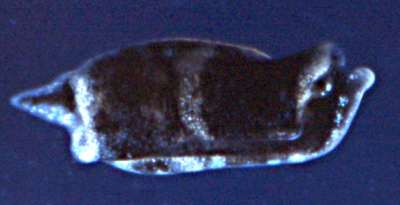
Dear Bill,
Here are some images of a slug found on algae in the Gulf of Cagliari, Sardinia, Italy, less than a meter deep. Theye are less than 4 mm long. I can't decide which genus and species they belong to, perhaps Melanoclamys? I would be grateful for any help in identifying them.
Regards
Alberto.
billr@seaslugforum.net
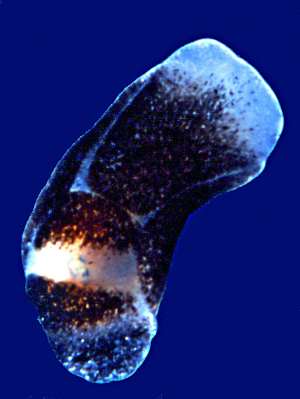
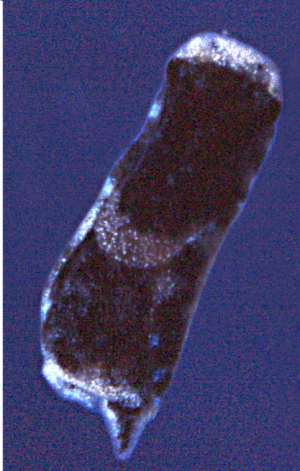
Dear Alberto,
At this small size we have the problem of deciding whether they are adults or juveniles. We would need to check their anatomy. The other problem is that there is a growing list of names for Atlantic aglajids all based on a few specimens from single localities. I am not even sure if all your animals are the same species as the animal in the lower left photo doesn't show the unequal 'tail' seen in the other two photos. It could of course just be contracted in this photo. My 'best guess' is that these are juveniles of Chelidonura africana, but as you can see in the discussions on that species, we still have quite a bit to learn about the aglajids from the Atlantic region.
Best wishes,
Bill Rudman
Colour variation in Chelidonura berolina
March 15, 2004
From: Marina Poddubetskaia
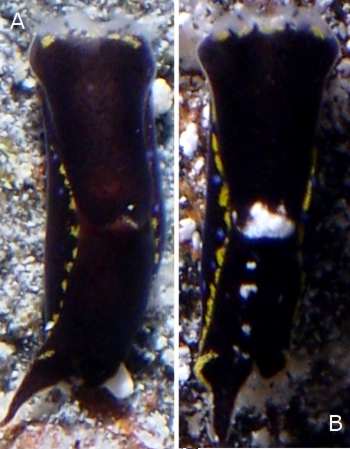
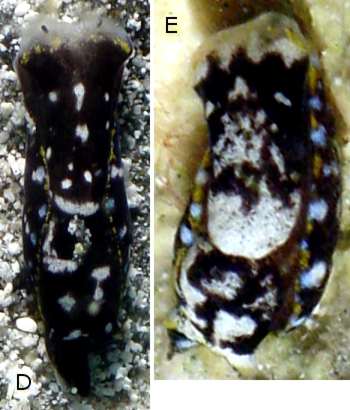
Dear Bill,
Here is a set of photos showing the colour variation in Chelidonura berolina within one restricted area, near Anne DuPont boat in the Southern Bahamas. All the specimens were found on the sand, on shallow bottoms.
Bill, do you think the Photo F is C. berolina too ? I photographed 2 specimens like this one.
Great Exuma, Bahamas, Western Atlantic. Site: Stocking Island, Hole n°2
Depth: 1m
Photos A, B, D, E: February 03, 2004
Size: A = 7-8mm, B = 5-6mm, D = 6mm, E = 5mm
Photos C, F: February 01, 2004
Size: C = 8-9mm, F = 10-11mm
Photos: Marina Poddubetskaia - Nembro website
Best wishes,
Marina.
nembro@nembro.info
Poddubetskaia, M., 2004 (Mar 15) Colour variation in Chelidonura berolina. [Message in] Sea Slug Forum. Australian Museum, Sydney. Available from http://www.seaslugforum.net/find/12418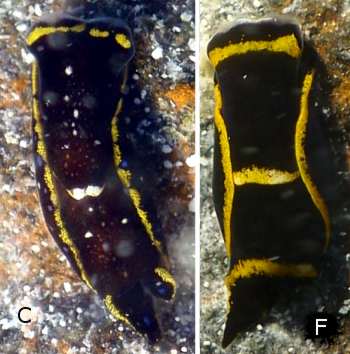
Dear Marina,
Thanks for this collection of photos showing the colour variation in C. berolina. This is indeed more evidence showing this species should really be identified as the eastern Atlantic species C. africana. I think we can say that the basic colour pattern is black with a yellow border to the parapodia and posterior shield and a yellow band across the head, some distance back fron the edge. Often the yellow lines are broken into a series of spots, and in some cases the yellow is absent. There are blue spots forming a sub marginal row on the parapodia and there can be blue spots on the inside of the 'tails' of the posterior shield. The blue spots can sometimes be absent, and sometimes are greatly enlarged.
There is a wide translucent white band across the front of the head shield. In most animals, but not all, there are white specks and patches scattered over the body. Sometimes the white predominates, producing an animal which could be best described as white with black speckling. There is usually a large white patch on the posterior tip of the head shield, which can sometimes be yellow or edged in yellow. Colin Redfern's photo [#12445] also suggests that the background colour can at times be brown rather then black.
You ask whether the animal in Photo F is the same? I am sure it is a colour variety. If you look at one of Anne Dupont's earlier messages [#9573] you will see an animal with similar broad transverse orange-yellow bands, but in that case the body is covered in white speckling, and is associated with a population of other animals with little sign of yellow on their bodies.
Re-looking at the Marcuses' descriptions, it is possible that C. hummelincki is a colour form of C. berolina, the difference I mentioned in the posterior 'tails' may be a result of preservation. However, as I said previously [#9573], the lack of any information on its living colour make its identification impossible.
With this extra information I think it is worth discussing the identity of this species in more detail. I have done this in a separate message [#12457]. I have little doubt that this is the same as the eastern Atlantic species Chelidonura africana.
Best wishes
Bill Rudman
Chelidonura africana, C. hummelincki & C. berolina
March 15, 2004
From: Colin Redfern
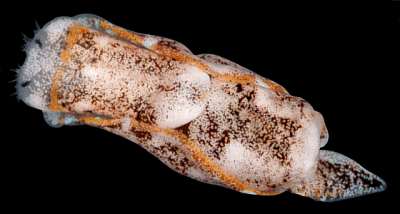
Dear Bill,
To contribute to the discussion of Chelidonura africana, [#11810], the attached photo is an example of the species that I referred to in Bahamian Seashells as Aglaja hummelincki. Also attached are two views of the shell from this specimen.
The photo of the animal is from Pl. 114, fig. 646D, and those of the shell are from Pl. 69, fig. 646E. The living animal was 4mm long, and was dredged from coarse sand in 2.5m on the lee side of Whale Cay, Abaco, Bahamas on August 5, 2000. Maximum diameter of the shell is about 1mm.
• Redfern, C. (2001) Bahamian Seashells: a Thousand Species from Abaco, Bahamas. BahamianSeashells.com, Inc.: Boca Raton, Florida
Best wishes,
Colin
bahamianseashells@att.net
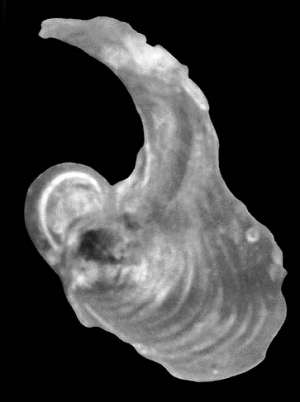
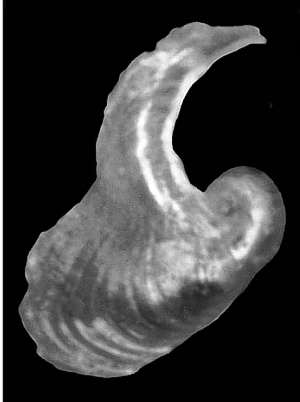
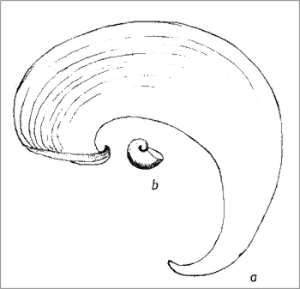
Thanks Colin,
To accompany your photos, here is a copy of Pruvot-Fol's drawing of the shell fragments removed from one of her preserved specimens. In it you can see the broad flattened thinly calcified part [a], which she described as 'membranous', and the small 'protoconch' section [b], which Pruvot-Fol described as 'calcified'. [Pruvot-Fol, 1953 -Text fig 6]
Your photo of the whole shell clearly shows the distinctive shape of the planar coiled protoconch. C. africana may not be the only species with this rather uniquely shaped spiral part of the shell, but it is the only species I have seen with this type of shell. Finding a similar shell in Caribbean animals, only adds to the weight of evidence showing that C. africana is to be found on both sides of the Atlantic. I discuss this in more detail in separate message [#12457].
• Pruvot-Fol, A. (1953) Etude de quelques opisthobranches de la cote Atlantique du Maroc et du Senegal. Travaux de l'Institute Scientifique Cherifien, Zoologie, 5: 1-105. (Pls.1-3)
Best wishes
Bill Rudman
Chelidonura berolina = C. africana [2]
March 15, 2004
From: Bill Rudman
In an earlier message [#11810] I suggested that the Caribbean species C. berolina, was most probably a western population of the eastern Atlantic - Mediterranen species C. africana. Recent photos from Marina Poddubetskaia [#12418] confirm this view. 'Typical' C. africana from the eastern Atlantic seems to be black with white speckling and yellow and blue markings in a characteristic pattern, as illustrated by Pruvot-Fol. In the western Atlantic however, although these typical colour forms can be found, there are also animals with a brownish background colour as well. Colin Redfern's recent message [#12445] illustrates this and also shows the similarity in shell shape on both sides of the Atlantic.
In summary, I think we can say that the basic colour pattern is black with a yellow border to the parapodia and posterior shield and a yellow band across the head, some distance back fron the edge. Often the yellow lines are broken into a series of spots, and in some cases the yellow is absent. There are blue spots forming a sub marginal row on the parapodia and there can be blue spots on the inside of the 'tails' of the posterior shield. The blue spots can sometimes be absent, and sometimes are greatly enlarged. There is a wide translucent white band across the front of the head shield. In most animals, but not all, there are white specks and patches scattered over the body. Sometimes the white predominates, producing an animal which could be best described as white with black speckling. There is usually a large white patch on the posterior tip of the head shield, which can sometimes be yellow or edged in yellow. Colin Redfern's photo [#12445] also suggests that the background colour can at times be brown rather then black.
As I have discussed earlier, it seems a number of names for Caribbean animals refer to this species.
• C. berolina Marcus & Marcus, 1970 - Marina Poddubetskaia's Photo E [#12418] is almost identical in colour to the original illustration of this animal. The population illustrated in Marina's messages show clear gradations in colour to forms identical to Pruvot-Fol's specimens from Morocco. Ortea & Martinez, (1997), suggest that this species is a juvenile of Chelidonura hirundinina, but the colour markings, and the shape of the posterior lobes are quite different.
• C. hummelincki Marcus & Marcus, 1970. As discussed earlier, no information is available on the colour of the living animal so it cannot be definitively identified. It is most likely a heavily speckled form of this species.
Ortea & Martinez (1997), in their description of Chelidonura cubana, suggest that C. africana, C. leopoldoi Ortea, Moro & Espinosa, 1996, C. hummelincki and C. cubana, are similar but distinct. Another small species from the Caribbean with a similar colour pattern, Chelidonura juancarlosi Ortea & Espinosa, 1998, was described a year later. All these species were described from very few specimens. I would not be at all surprised if further investigations show that these species are all colour variants of C. africana
References:
• Marcus, Er. & Marcus, Ev. (1970) Opisthobranchs from Curacao and faunistically related regions. Uitqaven van der Natuurwetenschappelijke Studiekring voor Suriname en de Nederlandse Antillen, 59: 1-129.
• Ortea, J., Moro, L. & Espinosa, J. (1996) Descripcion de dos nuevas especies del genero Chelidonura A.Adams, 1850 (Opisthobranchia, Cephalaspidea, Aglajidae) colectadas en la Isla del Hierro. Estudio comparado con C. africana Pruvot-Fol, 1953. Rev. Acad. Cabar. Cienc., 8: 215-229.
• Ortea, J. & Martinez, E. (1997) A new species of Chelidonura A.Adams, 1850 (Mollusca: Opisthobranchia: Cephalaspidea) from Cuba shores (in Spanish). Avicennia, 6/7: 137-140.
• Ortea, J. & Espinosa, J. (1998) Two new species of marine Mollusks (Mollusa: Gastropoda) colleted in the subarchipelagoes Jardines del Rey and jardines de la Reina, desribed in honor of the King and Queen of Spain for their first visit to Cuba. Avicennia, 8/9: 1-6.
Best wishes
Bill Rudman
Chelidonura berolina from Bahamas [2]
January 5, 2004
From: Anne DuPont
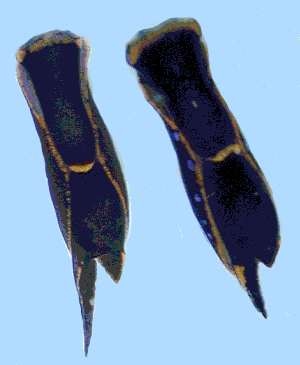
Note added 15 March 2004: C. berolina = C. africana. See message #12457.
Dear Bill,
Happy New Year. Hope that you and your family had a good holiday.
I am back in the Bahamas for the winter and finding the head shield slugs again.
And I have found another one that I cannot identify. Can you identify it for me, please? I brought two back to the boat and photographed them in a dish with a digital camera.
They were found on December 26, 2003 between 11 AM and 1 PM. They were in about 5 feet of water crawling on the sand during the day off Stocking Island, Exumas, Bahamas (Southern Bahamas). Their size was approximately ¼ inch long. I saw about 50 of them that day. They were all very tiny, about 1/8 to ¼ inch long. They were found in an area that I also found: Philinopsis depicta, Aglaja felis, Chelidonura hirundinina and Chelidonura berolina.
Thank you for your time.
Cordially,
Anne DuPont
Delray Beach, Fl., USA
akdupont@bellsouth.net
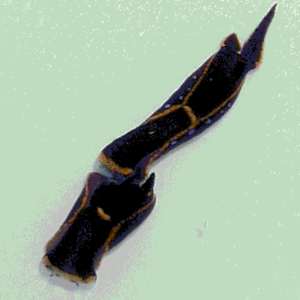
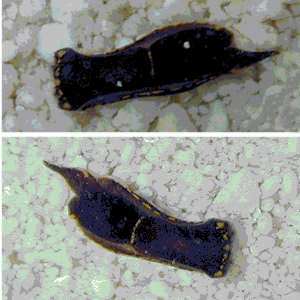
Dear Anne,
I am pretty sure this is the same species as in your accompanying message which you identified as Chelidonura berolina. In this pair the yellow spots form an almost continuous line. As I discuss in a separate message the colour range demonstrated in your photos make me pretty sure that this species is identical with the eastern Atlantic species C. africana.
Best wishes
Bill Rudman
Chelidonura berolina from Bahamas [1]
January 5, 2004
From: Anne DuPont
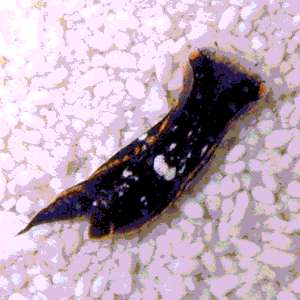
Note added 15 March 2004: C. berolina = C. africana. See message #12457.
Dear Bill,
Regarding my earlier post post of April 14, 2003 - Chelidonura berolina? from the Bahamas:
I am back in the Bahamas for the winter and finding the head shield slugs again, and was able to get better photographs.
They were found on December 26, 2003 about 1 PM. They were in about 5 feet of water crawling on the sand during the day off Stocking Island, Exumas; Bahamas (Southern Bahamas) Their size was approximately 1/8 to ¼ inch long. I saw about a dozen of them. They were found in an area that I also found: Philinopsis depicta, Aglaja felis; and Chelidonura hirundinina. Hope you enjoy the better photographs.
Thank you for your time.
Cordially,
Anne DuPont
Delray Beach, Fl., USA
akdupont@bellsouth.net
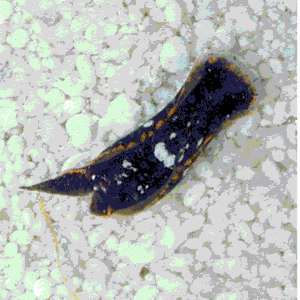
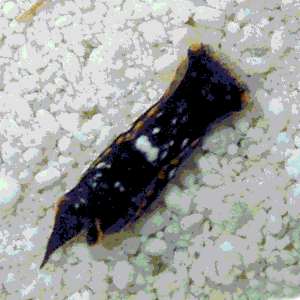
Dear Anne,
This certainly gives us a fuller picture of colour variation in this species. I am pretty sure the 2 animals in your accompanying message are also of this species. Looking at these photos, and at the ones in Colin Redfern's book, it would seem that this species is in fact a synonym of Chelidonura africana from the other side of the Atlantic. See my separate message. This is an excellent example of how more photos of even the most abundant animals can be very useful.
Best wishes
Bill Rudman
Chelidonura berolina = C. africana
January 5, 2004
From: Bill Rudman

Anne Dupont's accompanying messages, message 1, message 2, with photos showing the colour range in Chelidonura berolina, made me relook at illustrations of Chelidonura africana, a small species described from the west coast of Africa and known also from the Mediterranean where it was named C. italica. Comparing Gantes' colour painting in Pruvot-Fol's original description, it would seem that the Caribbean species, Chelidonura berolina, is almost certainly the same as C. africana showing the same range of colour variation. In an earlier message from Anne Dupont, specimens from the Caribbean, with little blue but considerable white speckling were illustrated.
It is also probable that Chelidonura leopoldoi Ortea, Moro & Espinosa, 1996, from the Canary Ids, and C. cubana Ortea & Martinez, 1997, from Cuba, are also colour forms of this species.
• Ortea, J., Moro, L. & Espinosa, J. (1996) Descripcion de dos nuevas especies del genero Chelidonura A.Adams, 1850 (Opisthobranchia, Cephalaspidea, Aglajidae) colectadas en la Isla del Hierro. Estudio comparado con C. africana Prubot-Fol, 1953. Rev. Acad. Cabar. Cienc., 8: 215-229.
• Ortea, J. & Martinez, E. (1997) A new species of Chelidonura A.Adams, 1850 (Mollusca: Opisthobranchia: Cephalaspidea) from Cuba shores (in Spanish). Avicennia, 6/7: 137-140.
Bill Rudman
PHOTOS: Upper Right: 3 specimens from Morocco. Plate 3, figs 37-39 - from Pruvot-Fol 1953. Lower: Colour variation from Bahamas [see Anne Dupont's messages].


Re: Chelidonura africana from the Azores
May 27, 2003
From: Juan Lucas Cervera
Hi Bill,
Here is the most recent reference to add concerning Chelidonura africana.
• Martinez, E., Malaquias, M.A.E. & Cervera, J.L. (2002). Chelidonura africana Pruvot-Fol, 1953 (MOLLUSCA, GASTROPODA): proposed designation of a neotype. Journal of Conchology, 37(4): 349-354.
Regards.
Lucas.
lucas.cervera@uca.es
Thanks Lucas,
Bill Rudman
Chelidonura africana from the Azores
May 24, 2003
From: Terry Gosliner

Here is a photo of Chelidonura africana which I photographed at São Miguel, Azores, in July 1988.
Best wishes,
Bill Rudman
tgosliner@calacademy.org
Gosliner, T., 2003 (May 24) Chelidonura africana from the Azores. [Message in] Sea Slug Forum. Australian Museum, Sydney. Available from http://www.seaslugforum.net/find/9909Thanks Terry,
Bill Rudman
Chelidonura berolina? from the Bahamas
April 14, 2003
From: Anne DuPont
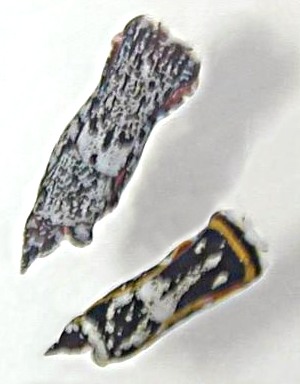
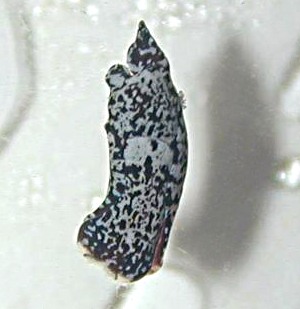
Note added 15 March 2004: C. berolina = C. africana. See message #12457.
Bill,
I apologize for sending you photos that are so bad but hopefully you can use them for information purposes. I found them over a range of 100 miles in the Southern Bahamas (The Exumas chain of islands) in depths from 2 feet to 10 feet. [January - March, 2003]. Their size was 1/8 inch to about 1 inch long.
In the same area that I found the Philinopsis sp and the Chelidonura hirundinina and the small black Aglaja I kept seeing on the sand what looked like little black dots moving, and because they were so tiny could not tell what they were.
So I scooped up a couple and brought them to the boat, put them in a dish and tried to photograph them with the digital camera.
Are they Aglaja hummelincki? I'll send one more photo...
Cordially,
Anne
akdupont@bellsouth.net
DuPont, A., 2003 (Apr 14) Chelidonura berolina? from the Bahamas. [Message in] Sea Slug Forum. Australian Museum, Sydney. Available from http://www.seaslugforum.net/find/9573Dear Anne,
I know you didn't want me to post these but I they are too interesting to ignore. I am sure your animal is the same as the one that Tom Thompson (1977) reported from Jamaica and Colin Redfern (2001) reported from Barbados as Aglaja hummelincki Marcus & Marcus, 1970. However I think they have misidentified the species. Aglaja hummelincki was described from 3 preserved specimens 3-4mm long, collected in Puerto Rico. There is no description of their living colour, and preserved they were described as 'black and have small pigment free blotches on back and parapodia'. There is little very distinctive in their description of the shape of the body other than 'left caudal lobe bigger then right one; no flagellum..'. In a brief discussion Marcus & Marcus try to justify describing a species without any colour information by saying "the colour of the species of Aglaja seems variable and of doubtful value (White, 1946)". This is of course nonsense. It is true that some species are quite variable in colour, but it is our responsibility to make some effort to investigate that variability before we try defining our species. Basically the only similarities between Thompson's specimens and the description of A. hummelincki were that they were small and had a black background colour.
Surprisingly, there is another species described by Marcus & Marcus, in the same paper, which fits Thompson's, Redfern's and your animals very well. It is Chelidonura berolina. It was also collected in Puerto Rico and it is small (5-8mm long alive). It is described as "chocolate brown spekled with white. Brownish orange margins of parapodia [are] interrupted by patches of sea green speckles. A brownish orange band transverses anterior part of head shield ... Left posterior mantle lobe long, pointed, right one shorter, rounded ...". Surprisingly, Marcus & Marcus contradict their earlier statement that colour is umimportant by saying "colour pattern ... distinguish C. berolina from other species of Chelidonura.
Thompson considers the following features to be characteristic - "two white areas one at the front of the head and one covering the bilobed rear of the cephalic shield. Body dark brown with irregular white patching .. brilliant yellow transverse band on the head. Posterior 'pallial points' [the tails] were unequal. Colour variants not uncommon, some very dark brown in colour lacking the yellow pigment". Colin Redfern shows a good range of colour varation.
The small size of Aglaja hummelincki, and lack of colour information, does raise the possiblility that it is the same species as C. berolina. However there is one important external difference. In C. berolina the original description states that the left caudal lobe is pointed and longer than the rounded right lobe. Although Marcus & Marcus describe the left caudal lobe of A. hummelincki as larger than the right, their illustration suggests the size difference is not great, and distinctly show that the right lobe is pointed, not rounded.
Another species which may be a later synonym of C. berolina is Chelidonura juancarlosi Ortea & Espinosa, 1998, another small species from the Caribbean with a similar colour pattern.
References:
• Marcus, Er. & Marcus, Ev. (1970) Opisthobranchs from Curacao and faunistically related regions. Uitqaven van der Natuurwetenschappelijke Studiekring voor Suriname en de Nederlandse Antillen, 59: 1-129.
• Ortea, J. & Espinosa, J. (1998) Two new species of marine Mollusks (Mollusa: Gastropoda) colleted in the subarchipelagoes Jardines del Rey and jardines de la Reina, desribed in honor of the King and Queen of Spain for their first visit to Cuba. Avicennia, 8/9: 1-6.
• Redfern. C., 2001. Bahamian Seashells: a Thousand Species from Abaco, Bahamas.
• Thompson, T.E. (1977) Jamaican opisthobranch molluscs I. Journal of Molluscan Studies, 43(2): 93-139, pls.1-3.
